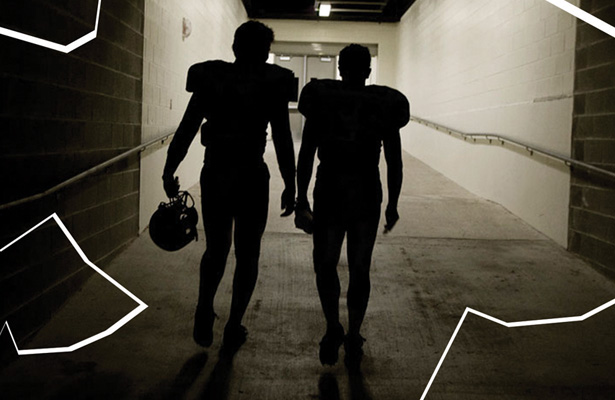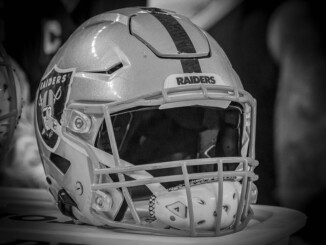
It was Jan. 22, 1989 at Super Bowl XXIII on the final drive for the San Francisco 49ers who trailed the Cincinnati Bengals 16-13. The ball was on their own 8-yard line with the clock showing 3 minutes, 10 second of remaining time.
You should know how this ends, right? The great Joe Montana, from the storied University of Notre Dame program, marched his offense down the field for the go-ahead touchdown to secure the franchise’s third Super Bowl victory. You may remember the excellent pass protection he had on that last drive from his offensive line of Harris Barton, Guy McIntyre, Randy Cross, Jesse Sapulo and Bubba Paris all who attended big time college programs. The backfield featured two University of Nebraska Cornhuskers. Split out wide were two receivers from less-storied programs, two players from Historically Black Colleges and Universities, more affectionately known as or HBCUs. These two players – John Taylor from Delaware State University and the great Jerry Rice from Mississippi Valley State University – were the main focal points of that game winning drive.
Rare are the days now when players from HBCUs play such prominent roles for Super Bowl teams or for any National Football League team for that matter. What used to be a breeding ground for NFL talent has become an afterthought for scouting departments throughout the league. From 1967 to 1976, 443 players were drafted by NFL teams. In one particular draft, 1974, four players from HBCUs went in the first round. In the 2014 NFL Draft, only three players from HBCUs were among the 256 who had their names called by the 32 franchises in the league.
It has been well documented about the exacerbating trend of players from HBCUs being overlooked and somewhat ‘blacklisted’ by NFL teams in the last 20 years. Many things are attributed to this happenstance but they all fall under one particular umbrella…a disparaging difference in funding for HBCUs as it relates to their larger and wealthier counterparts from Division I/Football Bowl Series schools. It all equates to the ‘Big Boys’ are eating the steaks while their smaller, weaker siblings are making due off of Ramen Noodles.
Fifty years ago during segregation, HBCUs consistently produced elite level athletes through their programs. Before the trend of integrating predominantly white college institutions, specifically in the south, black athletes had no choice but to display their gifts on the campuses of HBCUs. Former Dallas Cowboys Player Personnel Director Gil Brandt often said that he would spend as much time on the campus of Tennessee State University as he did the University of Tennessee. Following his lead were other NFL scouting departments which eventually led to an onslaught of black players excelling on the NFL gridiron. Taylor and Rice were joined in hallowed history by a ‘Who’s Who’ list of NFL Hall of Famers like Rayfield Wright, Bob Hayes, Larry Little, Mel Blount, John Stallworth, Art Shell, Jackie Slater, Richard Dent and Walter Payton to name a few.
Once legendary University of Alabama coach Paul “Bear” Bryant witnessed USC’s Sam Cunningham run rough shod through his Crimson Tide defense with ease in 1970, the idea to integrate a program who some thought would be the last to do such a thing suddenly began to creep into his mind. Soon the flood gates were open. Talented black athletes adopted a “Grass Is Greener” approach to their college studies. The lure of large Division I schools with their die-hard fan bases, huge alumni endowments, greater booster club funding and the chance to display their skills to millions of viewers on national television proved to be too much to turn their backs on. By doing this, the HBCUs have been left with a depleted talent pool from which to choose from and put on the field. Less talent on the field leads to fewer NFL quality players to be drafted.
The financial disparities when taking a closer look are astounding. The operating budgets are minuscule to say the least for HBCUs as opposed to Division I/FBS schools. Federal funding to HBCUs have been somewhat of a joke. According to documents made available through Georgia state open records law, Savannah State University operated it entire athletic department on a budget of $4.5 million last year. At the same time, the state’s “bell cow” school, the University of Georgia, paid its 10-member coaching staff a total of $6.4 million. The Bulldogs had a total operating budget of $16 million for the football program alone. The athletic programs throughout the university operated on a hefty $93 million budget. The disparity speaks for itself.
Savannah State is living in the lap of luxury in the eyes of Grambling State University. With a tradition that tops all HBCUs, historic Grambling was Stop Numero Uno for NFL scouts in the 1960s and 1970s. Legendary Grambling head coach Eddie Robinson amassed more than 400 wins in his five decades at the college in northern Louisiana.
On that very campus in 1967 was a boycott the day of the homecoming football game. It was a well-organized protest, led by Student Council President Willie Zanders. This particular protest was to bring awareness to the racial disparities in educational funding that permeated in the state of Louisiana 13 years after the Supreme Court had struck down the principle of “separate but equal” as unconstitutional.
A few seasons back Grambling staged another noteworthy protest. It wasn’t the student council that led it this time. This one was executed by Grambling’s own football team. Fed up by the 1,500-mile bus trips to and from games instead of flights, dilapidated conditions of their facilities, old outdated equipment and missed team meals the team boycotted an early-season contest against long-time rival Jackson State University. This brought to light to America the hardships of this once proud institution.
Studies showed that the state funding of Grambling dropped from $31.6 million in 2008 to just $13.8 million in 2013. Grambling was forced to cut the number of academic programs from 67 to 47 and laid off 127 employees. It deferred $24 million of maintenance and rehabilitation for classroom buildings, dormitories, the main library and football stadium. Alumni endowment did little to help the cause as well. With just under $5 million coming in annually from alumni, compared that to the state largest school, LSU, whose alumni endowments are reportedly around the $440 million is laughable.
Another HBCU institution in Louisiana, Southern University, also has had its share of financial barriers. After laying off 10 percent of its faculty to cut costs, the university failed to meet the requirements for the state’s GRAD Act. This ACT calls for an increase in both the graduating of students and retention of faculty, therefore Southern lost state funds and was unable to increase its tuition. Southern, like Grambling, seemed to have been greatly affected by Louisiana Governor Bobby Jindal eliminating $690 million in state funding from colleges and universities. LSU on the other hand just raised the ticket prices to its 90,000-seat football stadium to supplement the difference. That’s a luxury neither Grambling nor Southern are afforded on their campuses.
It has become commonplace in the last 10 years in late August and early September to see an HBCU pitted against one of the FBS powers. You may ask yourself “Why is Alcorn State playing the No. 1-ranked Alabama Crimson Tide?” Seems to be quite the mismatch putting a group of young men who didn’t even make honorable mention in their small division high school district against a team with Parade All-Americans on their taxi squad. There is a reason for these 77-0 maulings.
With the current financial condition of most HBCU athletic programs, a quick way to make some money is to volunteer your team to serve as that sacrificial lamb to a highly-ranked Division I, deep pocketed school. Through these scheduled slaughters, HBCUs and other FCS schools can walk away with a check up to $750,000 for their services. When compared to the gate and concession of a typical home game of say a Savannah State, which would actively seek two or three road contests of this manner, it’s evident as to why it’s a viable revenue stream. Shortly after the bands have marched off the field and the players are having their post-game meal, the money actually profited from that game can range from much as $15,000 to as low as $2,500.
Back in 2012, the Florida State University Seminoles hosted Savannah State. At first glance you see a score, 55-0, that doesn’t really look that bad considering the teams. Florida State has beaten a lot of teams by similar margins. The difference in this game was that it was played with a continuously running clock in an effort to keep the Seminoles from scoring more than 100 points.
It appears now that that financial stream has come to an end for HBCUs as well as major college football has gone to a four-team College Football Playoff where there are two national semifinals and a championship game. Most HBCUs will be left off the schedules of the big power schools due to ‘strength of schedule’ being one of the major criteria the selection committee takes into consideration. Scheduling a less-talented Division I school will be the trend moving forward for the power schools. So now a loaded Auburn University team obliterating Texas Southern 63-0 won’t hold water with the committee come time for selecting their four teams.
Forbes listed the most valuable college football teams of 2014 a few months back. Sitting at No. 1 was the University of Texas with an operating budget of $131 million, down from the $139 million for 2013. Rounding out the Top 5 were: Notre Dame, Michigan, Alabama and LSU bringing up the rear at $103 million. Mississippi Valley State on the other hand had to find a way to get by on a significantly smaller operating budget of $3.6 million for 2014. By that estimation, Alabama coach Nick Saban could take half of his annual salary and increase the Delta Demons budget 100 percent and still manage to somehow survive on the other $4 million he would have remaining from his hefty annual salary.
Federal funding and the way it is dispersed has more to do with the academic makeup of an institution and enrollment than what the football team record was for the season. HBCUs have annually under performed in the classroom, thereby lowering the graduation rate. In the modern world we live in today, HBCUs are not only losing prospective students to major universities, but now they are in full competition with community colleges, online universities, trade schools and the military. They can’t receive adequate funding if there is a paper trail of lowered performance and enrollment.
Many HBCU alumni feel the problem lies within. A history of mismanaged funds by the schools have basically rendered donations useless as an avenue to help with money issues. Some also feel that the focus of HBCUs has been out of place the last 30 years. Former NFL player and Jackson State University alum Eddie Payton (Walter’s brother) said in an interview, “It’s not that we are getting less money – it’s that everybody else is growing while we have basically stayed the same. We haven’t cultivated our fan bases and now the quality has gone down. It’s going to be hard to get those people back.”
Payton also went on to talk about when the downfall of HBCUs athletics, football in general, began its tailspin back in the late 1980s. He mentioned the very popular “Classic” football games between HBCU schools with large alumni bases and following. Moving them to places like Chicago and Indianapolis to help spread the brand of HBCUs and to make a little extra money, leaders of these schools often focused too much on the schools’ popular marching bands and the many parties surrounding the game instead of the football game itself.
“When you go to a steakhouse, the thing that makes or breaks your meal is the steak,” Payton said. “It’s not the salad or the baked potato. We haven’t been focusing on the most important issue and that’s the quality of football.”
There are no foreseeable solutions to the financial woes of HBCUs athletic programs. If they operate like most Division I powers and relied on the revenue created by the athletic program, they are inevitably doomed. The system currently in place has enough loopholes in it to have just enough of a case against providing the proper assistance it gives to the more fortunate institutions. Previous mishandling of federal funds, lower enrollment, poor graduation rates and overall leadership issues all have contributed to the demise of a once-proud contingency of learning institutions. At this rate, the chances of another Super Bowl winning drive highlighted by HBCUs alums are about as slim as the one Savannah State had against Florida State in 2012.




